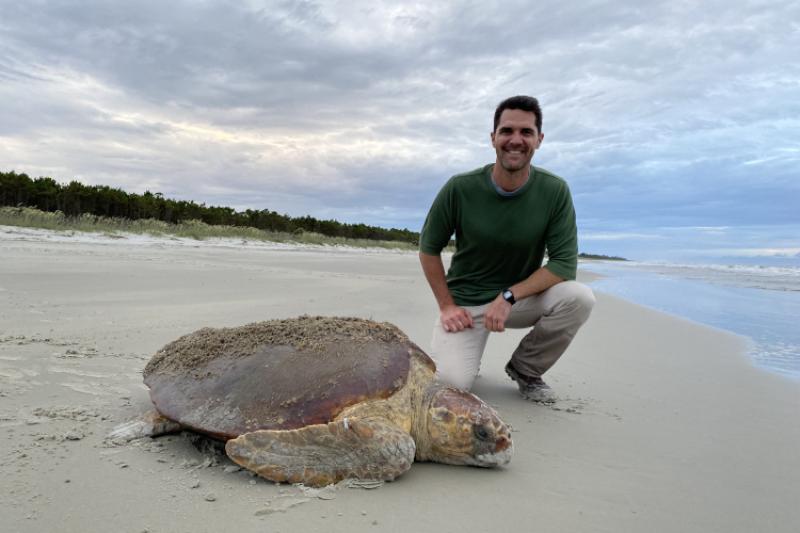Where did you grow up?
Geographically, I spent my childhood in Iowa City, Iowa and to a lesser extent in Portland, Oregon. As a biologist, I grew up catching turtles and snakes in the creeks and prairies of the Midwest, spotting invertebrates in the rocky tidepools of the Pacific Northwest, saving lizards from the subterranean garbage cans in Southwest Florida, and, a bit later, protecting sea turtles in coastal Georgia.
Where did you go to school and in what subject did you get your degree(s)?
I took a rather circuitous route through undergrad with stops at the University of West Florida studying marine biology and the University of Iowa studying biology before completing my Bachelor’s Degree in Zoology at the University of Florida. After a year conducting research with the Queensland Environmental Protection Agency in Australia, I earned my Master’s Degree in Biology from Florida State University. Then I returned to the University of Florida to complete my Doctoral Degree in Zoology as a member of the Archie Carr Center for Sea Turtle Research.
How did you come to work at the Southeast Fisheries Science Center?
I’ve been a biologist since I could walk, so no other job was really an option. I am the son of two medical doctors, but medicine never appealed to my sense of wonder, or love for biodiversity and adventure. Seeing the world and finding animals was my abstract “dream job” as a kid, but it wasn’t until I volunteered on a sea turtle research project at the age of 15 that a career in science became my goal. I continued working for the Caretta Research Project (based out of Savannah, Georgia) as a volunteer and intern while honing my academic knowledge in biology and collecting degrees. While completing my Ph.D., I was hired as the research director of the project and served in that position for 11 years. There, I applied cutting-edge science to unravel the mysteries of sea turtle biology while guiding intrepid groups of public volunteers to experience sea turtles and science firsthand. I also established many productive collaborations and connections throughout the sea turtle community, both regionally and internationally. Twenty-five years and three degrees later, I learned about the new position of Sea Turtle Branch Chief at the Southeast Fisheries Science Center. Following the urge to broaden my impact and reach in sea turtle conservation, I applied and eventually accepted the position in the summer of 2022.
What do you do at the science center?
I am the Sea Turtle Branch Chief within the Marine Mammal and Turtle Division. Our mission is to conduct science that leads to improved knowledge and meaningful conservation of marine mammals and turtles and their habitats. I work with division leadership to provide administrative support for division members and our activities, plan and oversee the execution of our budget, and serve as the point of contact for the branch. As the Sea Turtle Branch Chief, I oversee budget and research planning, conduct and publish research, and help facilitate the success of the branch and its members. Our sea turtle research includes:
- Characterizing population structure and investigating shifts in distribution and demography
- Estimating population size, density, and evaluating trends in abundance
- Understanding animal movements and behavioral responses to oceanographic conditions and climate change
- Identifying human threats and quantifying individual and population-level impacts
From these data, we apply state-of-the-art analytical tools and modeling approaches to generate scientific products and decision-support tools to answer complex research and management questions.
What do you like most about your position?
I enjoy conducting research that helps reveal the biological mysteries of sea turtles that, in turn, help guide conservation and management actions. As terrestrial apes, human researchers have a real challenge on our hands when trying to understand turtle biology. Sea turtles spend almost all of their lives at sea, so our research efforts require creativity to find tools that allow us to follow turtles throughout their lives and learn their ways. This challenge makes discoveries that much more rewarding!
What advice would you have for someone interested in a career at NOAA Fisheries?
I guess one piece of practical advice would be to start early. If you think a career in government is something that you want to pursue, there are many perks to longevity in the agency. Additionally and more abstractly, be curious. Asking questions about things you don’t understand, pursuing topics that might seem daunting, and remaining open and flexible to different perspectives will help you immensely and keep things exciting—not only in NOAA Fisheries, but elsewhere as well.
Is there a book, quote, or person that influenced you to be the person that you are today? Tell us why.
My grandfather used to say “Good, better, best, never let it rest, always make your good better and your better best.” In all aspects of my job as a scientist and a branch chief, I try to apply this mindset. I think seeing failures as opportunities to get better is an important way to stay positive and keep moving in the right direction.
What do you like to do outside of work?
Whenever I can get away, I love traveling on a shoestring budget to the far corners of the world in search of wild animals and wild spaces with my brother. We have already made a lifetime of memories, but there are many more to come. I also cherish relaxing days around the house, wandering remote beaches, and enjoying local restaurants and cinemas with my fiance. To round it out, I love exercising, reading, SCUBA diving, watching sports, and bar hopping with my Pfamily.




